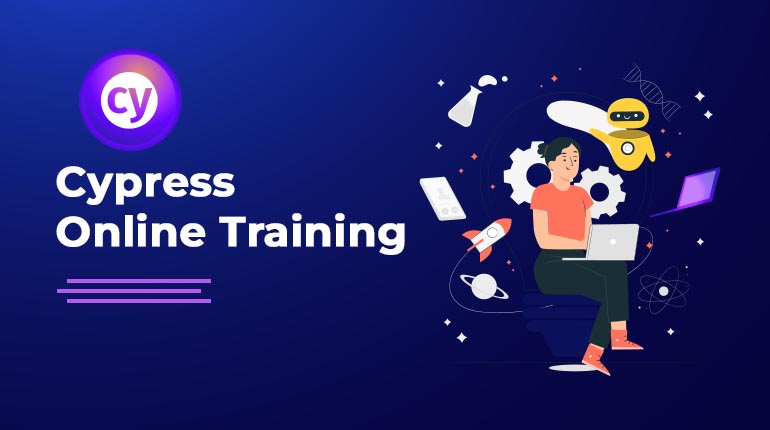
Cypress offers several key features that make it a powerful tool for end-to-end testing. Some of these include:
-
Automatic waiting: Cypress automatically waits for elements to appear on the page before interacting with them, which eliminates the need for explicit waits and makes tests more stable.
-
Time-travel debugging: Cypress allows you to "rewind" and replay actions in your test, making it easy to debug and understand what went wrong.
-
Real-time reloading: Cypress automatically reloads the browser when changes are made to the test code, making development and debugging faster.
-
Built-in assertion library: Cypress includes a built-in assertion library, which makes it easy to check that your application is behaving as expected.
-
Easy integration with other tools: Cypress can be easily integrated with other tools such as Webpack and Mocha, allowing you to use it with your existing workflow.
-
Automatic waiting: Cypress automatically waits for elements to appear on the page before interacting with them, which eliminates the need for explicit waits and makes tests more stable.
-
Cypress test runner: Cypress has its own test runner, which allows you to easily run your tests and see the results in the browser.
-
Focused on E2E testing: Cypress is built for end-to-end testing, it allows you to test your entire application, as opposed to unit testing.
This course would be ideal for developers, QA engineers, and anyone else who is responsible for testing web applications. If you are looking to improve the reliability and maintainability of your end-to-end tests, or if you are looking for a more efficient way to test your application, then this course would be a good fit for you.
Prerequisites for the course would be a basic knowledge of JavaScript and web development concepts, as Cypress is a JavaScript-based framework. Familiarity with web development concepts such as the DOM (Document Object Model) and the browser developer tools would be helpful.
A typical Cypress course syllabus may cover the following in-depth concepts:
-
Installation and setup: This would cover how to install Cypress on your machine and set it up to work with your application.
-
Writing tests: This would cover how to write tests for your application using Cypress, including how to interact with elements on the page, how to use the built-in assertion library, and how to handle asynchronous code.
-
Cypress API: This would cover the various methods and properties that are available in the Cypress API, including how to interact with the browser, how to debug and troubleshoot tests, and how to work with cookies and local storage.
-
Advanced Cypress concepts: This would cover more advanced topics such as working with iframes, testing web applications with multiple windows, and using Cypress plugins.
-
Cypress Best Practices: This would cover the best practices in Cypress testing, including how to organize and structure your tests, how to write maintainable and readable code, and how to debug and troubleshoot tests.
-
Cypress and Continuous Integration: This would cover how to integrate Cypress with continuous integration tools such as Jenkins, Travis CI, and CircleCI
-
Cypress Test Runner: The Cypress Test Runner is a browser-based interface that allows you to run and debug your tests. This topic would cover how to use the Test Runner, including how to run tests, how to debug tests, and how to view test results.
-
Cypress Dashboard: Cypress Dashboard is a service that allows you to record and view the results of your tests. This topic would cover how to use the Dashboard, including how to record tests, how to view test results, and how to share test results with others.
-
Cypress and Webpack: Cypress can be easily integrated with Webpack, a popular JavaScript module bundler. This topic would cover how to set up Cypress with Webpack, including how to configure Webpack to work with Cypress and how to use Webpack plugins with Cypress.
-
Cypress and Mocha: Cypress can also be integrated with Mocha, a popular JavaScript testing framework. This topic would cover how to set up Cypress with Mocha, including how to use Mocha's assertion library with Cypress and how to run Mocha tests using Cypress.
-
Cypress and CI/CD: This topic would cover how to set up Cypress to run in a continuous integration/continuous delivery (CI/CD) pipeline, including how to configure Cypress to run on different environments, how to set up parallel testing, and how to handle test failures in a CI/CD pipeline.
-
Cypress and Accessibility: This topic would cover how to test web accessibility using Cypress, including how to test for accessibility issues such as low contrast, missing alt tags, and keyboard accessibility.
-
Cypress and Performance: This topic would cover how to measure and test web application performance using Cypress, including how to measure page load times, network requests, and browser performance metrics.
-
Cypress and Security: This topic would cover how to test web application security using Cypress, including how to test for cross-site scripting (XSS) and cross-site request forgery (CSRF) vulnerabilities.
-
Real-world examples: This would cover real-world examples of how to use Cypress to test web applications, including examples of common use cases and best practices.
-
Project work: A hands-on project work would be a great way to cement the concepts learned in the course and apply the knowledge in a real-world scenario.
-
Cypress Training FAQ’s:
Cypress is a JavaScript-based end-to-end testing framework that allows you to test web applications. It provides a simple API for interacting with web pages, and allows you to write tests in a way that is similar to how a user would interact with your application.
Cypress is designed specifically for end-to-end testing, and provides features such as automatic waiting, time-travel debugging, and real-time reloading, which make it faster and more reliable than other testing frameworks.
Some of the key features of Cypress include automatic waiting, time-travel debugging, real-time reloading, a built-in assertion library, and easy integration with other tools.
You can install Cypress by running the following command in your terminal: npm install cypress
You can run your tests with Cypress by running the following command in your terminal: npx cypress open
Yes, Cypress can be easily integrated with Webpack and Mocha, allowing you to use it with your existing workflow.
Yes, Cypress can be integrated with continuous integration/continuous delivery (CI/CD) pipeline, including how to configure Cypress to run on different environments, how to set up parallel testing, and how to handle test failures in a CI/CD pipeline.
Cypress provides a built-in debugging tool called the "time-travel" feature, which allows you to "rewind" and replay actions in your test, making it easy to debug and understand what went wrong. Additionally, you can use browser's dev tools.
Yes, Cypress can be used for accessibility and security testing, it has features that allows you to test for accessibility issues such as low contrast, missing alt tags, and keyboard accessibility, and also test for cross-site scripting (XSS) and cross-site request forgery (CSRF) vulnerabilities.
You can improve the maintainability of your tests with Cypress by following best practices such as organizing and structuring your tests, writing readable and maintainable code, and debugging and troubleshooting tests effectively.
